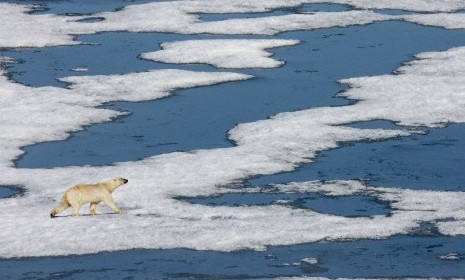Should BP be drilling in Alaska?
BP's on track to start drilling a risky new type of well in a remote region of the Arctic this fall, despite the offshore drilling ban. What could possibly go wrong?

Even as its oil keeps gushing in the Gulf of Mexico, BP is preparing to start a controversial new drilling project about three miles off the north coast of Alaska. BP's "Liberty" project gets around the Obama Administration's offshore-drilling moratorium — currently in legal limbo — because the work is being done from a 31-acre artificial island in the Beaufort Sea. If the plan is given a final green light from the Obama administration, drilling could begin this fall. (Watch an MSNBC report about BP's Alaska drilling plan.) Here's a quick guide to BP's newest brouhaha:
What's BP's Liberty project?
The Liberty well is an "extended reach" project, meaning BP will drill two miles down and then six to eight miles horizontally to tap the oil reservoir. (See info-graphic here.) The estimated 100 million–barrel oil cache is located under environmentally sensitive federal waters.
The Week
Escape your echo chamber. Get the facts behind the news, plus analysis from multiple perspectives.

Sign up for The Week's Free Newsletters
From our morning news briefing to a weekly Good News Newsletter, get the best of The Week delivered directly to your inbox.
From our morning news briefing to a weekly Good News Newsletter, get the best of The Week delivered directly to your inbox.
Has this been done before?
Oil companies building gravel drilling islands in shallow Arctic waters isn't new, but the Liberty project would be the largest horizontal well ever attempted, just shy of the 8.33-mile limit even studied by drilling researchers. BP in 2008 called the project "one of its biggest challenges to date" in "some of the harshest weather on Earth" — which also apparently makes the project "about as sexy as it gets" for drilling engineers.
Is it safe?
Experts say extended-reach drilling is more prone to natural gas "kicks" like the kind that set off the Deepwater Horizon explosion, and that they are harder to detect. The project did require an environmental review, but instead of performing an independent analysis, federal regulators reportedly allowed BP to write its own — a "bizarre" upheaval of protocol, according to two government scientists quoted in The New York Times.
A free daily email with the biggest news stories of the day – and the best features from TheWeek.com
What's BP's worst-case scenario?
BP's environmental assessment acknowledges that a large spill — its worst case is 20,000 barrels a day — would have a dire effect on polar bears, seals, walruses, whales, and other wildlife, but discounts such a spill as very unlikely. Even if there was a blowout, BP says, its gravel island was designed to contain the resulting spill.
Is that overly rosy?
Environmentalists think so. But Alaska Dispatch's Craig Medred says there's a "non-alarmist" case to be made: By the time BP hits oil, months after the drilling starts, "the Liberty drill site will be surrounded by ice on which heavy equipment can be driven. If this one blows, BP can berm the oil up in a snow-banked reservoir, pump it out and haul it away." He also notes that BP's hopes of harvesting 40,000 barrels a day rest on forcing the oil out with two large water pumps, so another unchecked Gulf-style "gusher" is unlikely.
Is there a worse worst case?
Several. Critics dismiss outright the notion that a small gravel island could contain gushing oil, and point out that — unlike in the Gulf — there's no easy way to get oil containment and cleanup equipment to the remote and often-inaccessible Arctic coast. Marine scientists' worse-case scenario, says Rolling Stone's Tim Dickinson, is an autumn blowout that, due to ice-covered waters, "could flow unabated until relief wells could be drilled the following summer." By that time, it would have spread as far as Russia and Norway, devastating marine wildlife across a vast swath of the Arctic.
Should the Liberty project be stopped?
The Obama administration says it's taking a long, hard look before giving BP the final go-ahead. But some experts say the real problem is drilling in the area at all — which will probably resume early next year regardless of what happens with BP's Liberty well. "Drilling in the Arctic should make the hairs stand up on the back of your neck," says former NOAA chief scientist Sylvia Earle. "There are some places you should not drill, period."
Sources: New York Times, Alaska Dispatch, Rolling Stone, Talking Points Memo
-
 Political cartoons for December 14
Political cartoons for December 14Cartoons Sunday's political cartoons include a new White House flag, Venezuela negotiations, and more
-
 Heavenly spectacle in the wilds of Canada
Heavenly spectacle in the wilds of CanadaThe Week Recommends ‘Mind-bending’ outpost for spotting animals – and the northern lights
-
 Facial recognition: a revolution in policing
Facial recognition: a revolution in policingTalking Point All 43 police forces in England and Wales are set to be granted access, with those against calling for increasing safeguards on the technology